Alopecia Areata:Know- [Here]-Types,Symptoms,Causes & Alopecia Picture-2020
Alopecia Areata, what is this?
Alopecia Areata is a sudden loss of hair in patches that involves little or no inflammation.
In the majority of cases, small patches found around the size of a quarter.
However, for most people, hair loss is nothing more than that a few patches.
But in some cases, it can be more extreme.
In this -healthy-myself.com we will share-
Alopecia Areata in detail.
So, please take your seat and grab a glass of water.
Stay with us just 7 minutes only and get all the information step by step.
Contents
1. What is Alopecia Areata?

Alopecia Areata does not directly make people sick or giving pain nor it is contagious.
However, it can be difficult to adapt emotionally.
It may surprise you to know that the word ultimately derives from “alōpēx,” the Greek word for “fox,”.
But the connection makes sense.
If you think of a fox who is afflicted with mange, a disease with symptoms that include, among other things, loss of hair.
Sometimes, we will found complete hair loss on the scalp.
Or, in extreme cases, the entire body.
The condition can affect anyone or any age and gender.
All though most cases occur 25-30 years of age.
Sometimes, it can lead to the complete loss of hair on the scalp which is called –alopecia total.
Or, in extreme cases, the entire body called as-Alopecia Universalis.
2.Types Of Alopecia:
There are 8 different types of alopecia, classified based on how the hair falls out.
2.1.Alopecia Totalis :
It starts with small, round patches of hair loss.
Then it progresses until there is total scalp hair loss.
2.2.Alopecia Universalis :
In this case, all body hair is lost.
2.3.Androgenetic Alopecia:
It is also known as male-pattern baldness that occurs in both men and women.
This disorder can start after puberty in women.
It develops slowly over 15 to 30 years of age group and increases with age.
2.4.Alopecia Areata:
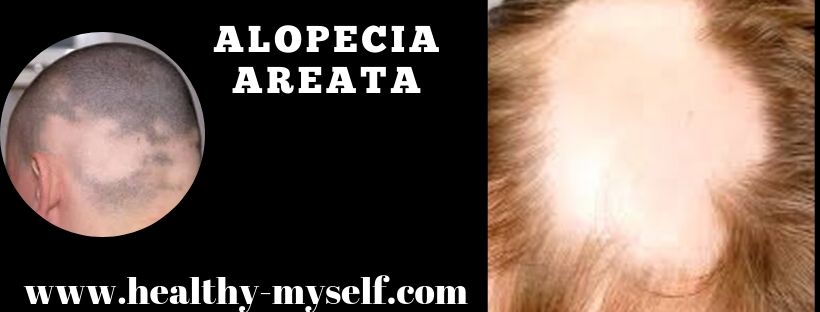
In this type People experience the sudden or sometimes unrecognized falling out of hair in patches here and there or spots.
Patches can vary in size from 1/8 inch to 4 inches in diameter.
The affected areas are usually lighter in color due to the poor blood supply to this particular area.
2.5.Diffuse Alopecia:
It is also known as Alopecia Areata Incognita.
In this case, it is a rare form of Alopecia Areata.
And affects primarily young females, and the hair loss occurred on the head is radical and sudden.
2.6.Postpartum Alopecia:
It is temporary hair loss experienced at the end of pregnancy.
Very little normal hair loss occurs during pregnancy.
However, the sudden and excessive spreading takes place from 3 to9 months after delivery.
As a whole, the growth cycle generally returns to its normal condition within a year after the baby is delivered.
2.7.Traction Alopecia:
It is the most common balding disorder among young women and girls with highly textured hair.
Baldness occurs when the hair is pulled too tight meaning the hair is pulled out of the follicle and taking out the hair root and the bulb.
Destroying the hair shaft may cause white bumps and pus, or scaling may occur around the affected area.
2.8.Cicatricial Alopecia.
It Is Also known as Scarring Alopecia.
The condition Cicatricial Alopecia is a type of hair fall.
In this case, hair follicles are destroyed and replay scar tissue.
There are two types of Cicatricial Alopecia-
-1. Primary Alopecia
2.secondary Alopecia
Primary Cicatricle Alopecia:
The hair loss is caused directly by inflammation of the hair follicles, the causes of which are little understood.
Secondary Cicatricle Alopecia:
This refers to scarring hair loss which occurs as a result of an event or process unrelated to the follicles, such as burns or infections.
3.Alopecia Meaning:
Firstly, Middle English speakers borrowed the Latin word alopecia.
Which comes from “alōpekia,”.
It is a Greek term that can be translated as “mange on foxes.”
It is a disease with symptoms of loss of hair.
4.Symptoms Of Alopecia:
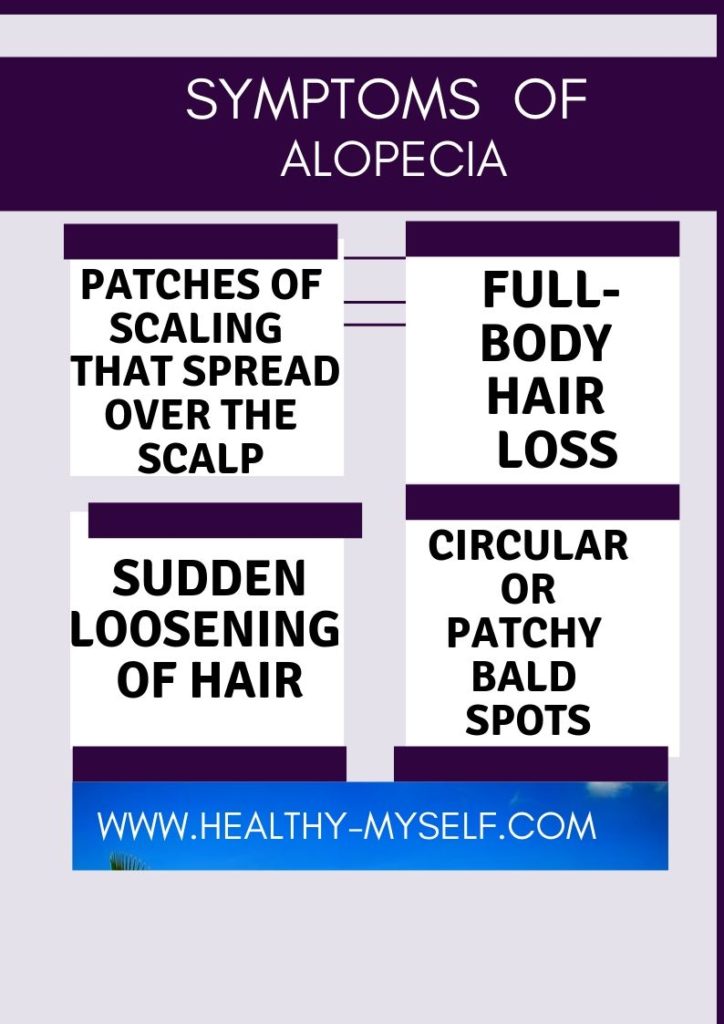
Symptoms of Alopecia may include:
A person may found gradual thinning on top of the head.
And this is the most common type of hair loss.
It affects both men and women as they age.
However, in men, hair often begins to recede from the forehead in a line that resembles the letter like M.
Women typically retain the hairline on the forehead.
But have a broadening of the part in their hair.
4.1.Circular or patchy bald spots –

Some people experience smooth, coin-sized bald spots.
This type of hair loss usually affects the scalp and very difficult to grow naturally.
But it sometimes also spreads in beards or eyebrows area.
In some cases, you may found that- your skin may become itchy or painful before the hair falls out.
4.2.Sudden loosening of hair-
A physical or emotional shock can cause hair to fall.
Handfuls of hair may come out when combing and washing your hair.
Or even after gentle tugging also.
This type of hair loss usually causes due to-overall hair thinning and not bald patches.
4.3.Full-body hair loss-
Some conditions and medical treatments can cause that.
Such as chemotherapy for cancer treatment.
It can result in the loss of hair or all over your body.
The hair usually grows back.
4.4.Patches of scaling that spread over the scalp-
This is a typical sign of ringworm.
It may be accompanied by the broken hair, redness, swelling and, at times, oozing.
5.Alopecia Causes-
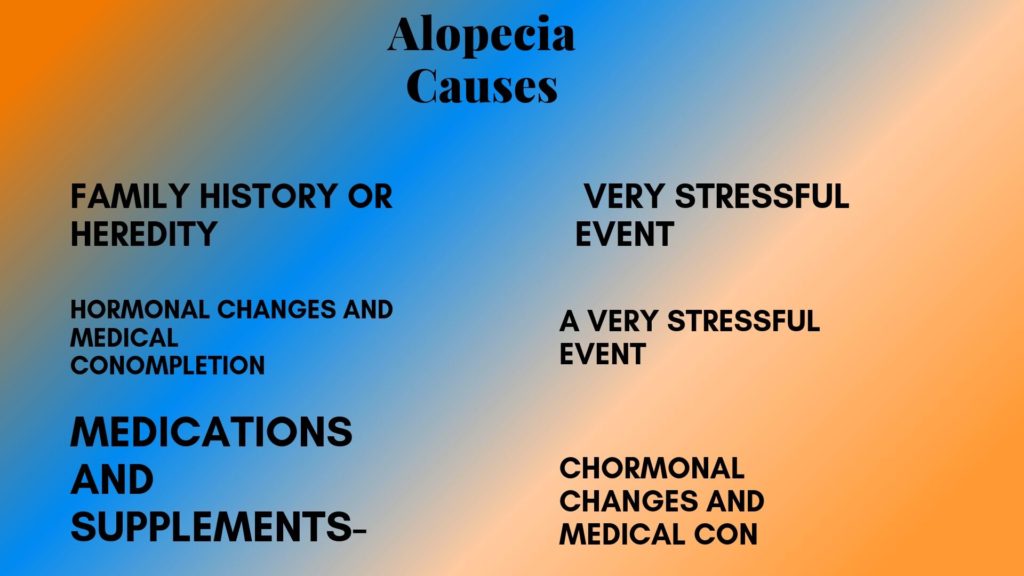
5.1.Family history or heredity:
The most common and famous cause of hair loss is a hereditary condition.
It is called male-pattern baldness or female-pattern baldness.
This usually occurs gradually with the aging and in predictable patterns.
Typically a receding hairline and bald spots in men and thinning hair in women have found.
5.2.Hormonal changes and medical conditions-
A variety of conditions can cause permanent or temporary hair fall also.
It includes hormonal changes due to so many causes-
such as-
- pregnancy
- childbirth
- menopause
- and thyroid problems.
5.3. Medical conditions include alopecia areata-
Which causes patchy hair fall and scalp infections.
Such as –
- Ringworm
- and a hair-pulling disorder
5.4.Medications and supplements-
Hair loss can be a side effect of-
- certain drugs, such as those-
- used for cancer
- arthritis problems
- prolong depression
- heart problems
- gout
- high blood pressure.
- Radiation therapy to the head
- The hair may not grow back as previously.
5.5.A very stressful event-
However, many people experience a general thinning of hair found after several months of physical or emotional shock.
This type of hair loss found on a temporary basis.
5.6. A very stressful event –
Excessive hairstyling is one of the causes that pull your hair tight.
Such as pigtails or cornrows.

It can cause a type of hair loss called- Traction alopecia.
Hot oil hair treatments and permanents can cause inflammation of hair follicles that leads to hair loss also.
If scarring found, then hair loss could be permanent.
6.Alopecia Picture:
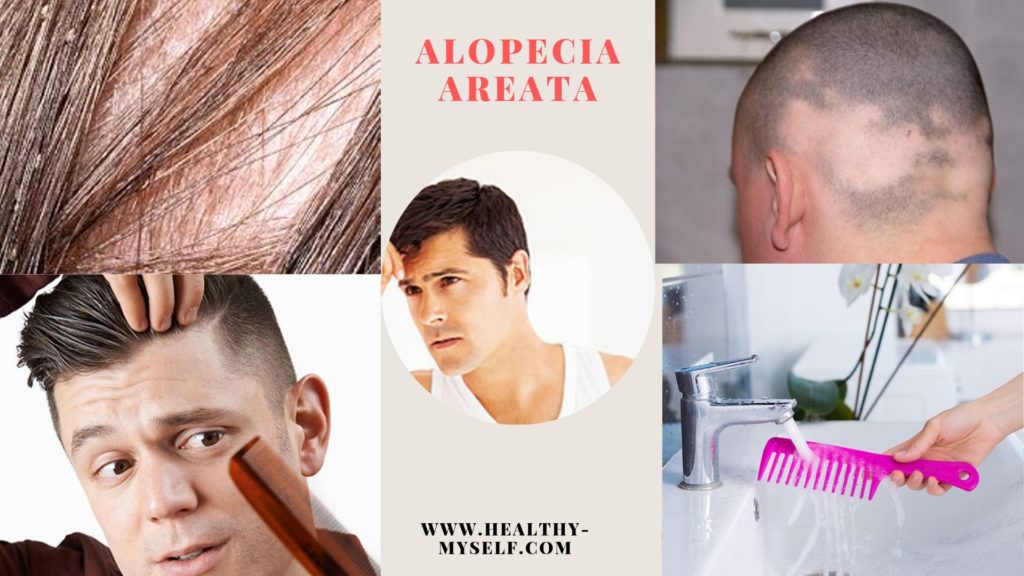
It is is an autoimmune condition that results in hair fall when the Immune System attacks hair follicles.
Hair loss may occur on the head as patches and sometimes on the whole scalp.
Or even the body.
Alopecia areata can occur at any age.
But young people under the age of 20 are most often affected.
The disorder is equally prevalent in both genders.
Approximately 2% of people in the U.S. will suffer from alopecia areata over the course of their lifetime.
In a nut cell, there is no cure for Alopecia Areata but it can be well managed with a variety of treatments and precautions.
It is also possible for hair to grow back as previously. Episodes of hair loss may be recurrent.
7.Conclusion:
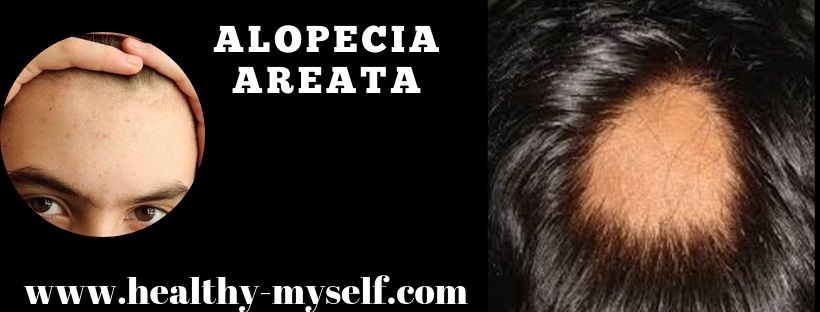
Hair loss or Alopecia is a very common complaint of every person.
Patients may complaints of shedding hair and diffuse or localized alopecia.
The Typical diagnosis of hair loss includes a number of disorders causing cicatricial or noncicatricial alopecias.
We have to take care of hair and consult doctors if required.
You can read here also-
https://en.wikipedia.org/wiki/Alopecia_areata
I think you have enjoyed this post very much.
I’d like to grow my readership.
Can you help me out by sharing this blog post with your family, friends & colleagues?
What other ideas can you add to this list that I may have not mentioned please write to us?

